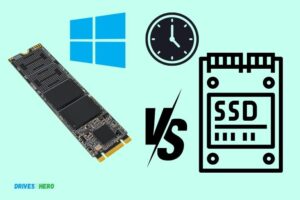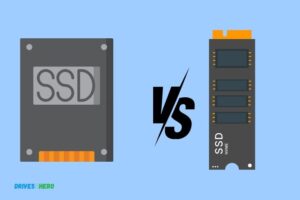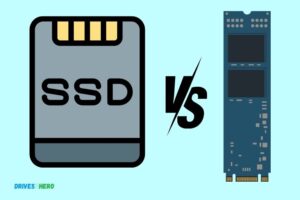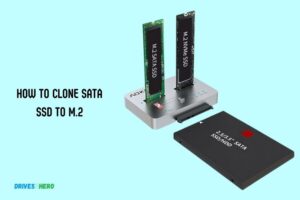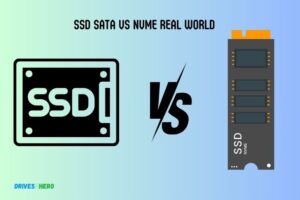Nvme Vs Sata Ssd Speed Test: Find Out Here!
In terms of speed, NVMe SSDs are much faster than SATA SSDs. While SATA SSDs have a maximum speed of 600 MB/s, NVMe SSDs can reach up to 3500 MB/s.
The sequential read and write speeds of NVMe SSDs are incomparably higher than those of SATA SSDs.The main reason for the speed difference between the two types of SSDs is their interfaces.
SATA SSDs use the Serial ATA interface, which was designed for hard drives and has a slower data transfer rate.
On the other hand, NVMe (Non-Volatile Memory Express) SSDs use the PCIe (Peripheral Component Interconnect Express) interface, which provides a significantly higher data transfer rate.
The significant speed advantage of NVMe SSDs over SATA SSDs makes them the superior choice for high-performance tasks.
Whether it’s intensive data analysis or high-end gaming, NVMe SSDs can handle the heavy data transfer with ease, providing a smoother and faster experience.
4 Speed Metrics For NVMe Vs SATA SSD
| Speed Metric | NVMe SSD | SATA SSD |
|---|---|---|
| Sequential Read Speed (MB/s) | 2000-3500 | 500-550 |
| Sequential Write Speed (MB/s) | 1750-2500 | 450-500 |
| Random Read Speed (IOPS) | 450,000-700,000 | 90,000-100,000 |
| Random Write Speed (IOPS) | 400,000-500,000 | 80,000-90,000 |
Key Takeaway
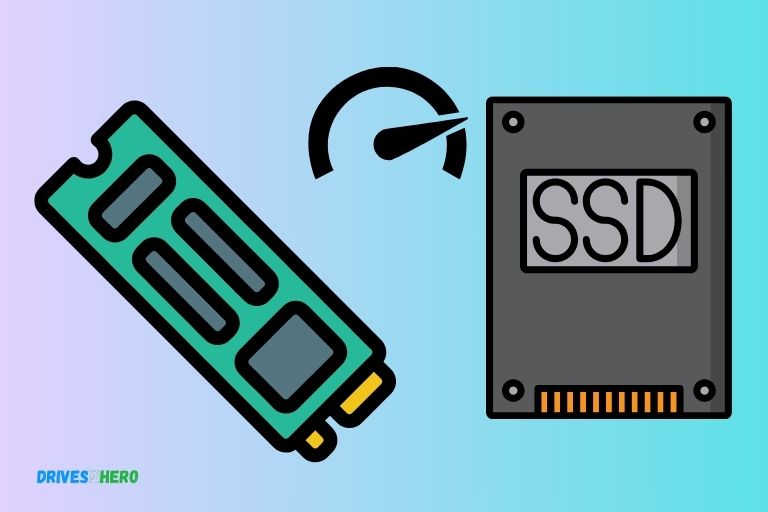
Five Facts About NVMe vs SATA SSD Speed Test
Understanding Nvme And Sata Ssds
Nvme and Sata SSDs offer different speeds, making a speed test crucial for knowing the difference. Explore and understand the varying performance levels of these two types of SSDs to make an informed decision.
When it comes to storage options for your computer, solid-state drives (SSDs) have become the go-to choice for their speed and reliability.
However, there are different types of SSDs available, including Nvme and Sata SSDs. Understanding the characteristics and differences between these two can help you make an informed decision.
Characteristics And Differences Between Nvme And Sata Ssds:
Nvme (Non-Volatile Memory Express) SSDs:
- Utilizes the PCIe (Peripheral Component Interconnect Express) interface for data transfer.
- Offers faster read and write speeds, resulting in significantly improved performance compared to traditional hard disk drives (HDDs) and Sata-based SSDs.
- Designed primarily for high-end systems that require exceptional speed and responsiveness, such as gaming rigs or workstations.
- Can handle intensive workloads, including heavy file transfers, large data processing, and multitasking.
Sata (Serial Advanced Technology Attachment) SSDs:
- Uses the Sata interface, which is commonly found in most computers and laptops.
- Provides good performance for day-to-day computing tasks and general use.
- More affordable compared to Nvme SSDs, making them a budget-friendly choice for those seeking faster storage without breaking the bank.
- Suitable for average users who primarily engage in web browsing, document editing, and media consumption.
Advantages And Disadvantages Of Nvme And Sata Ssds:
Nvme SSDs:
Advantages:
- Lightning-fast data transfer speeds, offering incredible performance.
- Reduced latency, leading to quicker system responsiveness.
- Ideal for resource-intensive tasks, such as gaming, video editing, and content creation.
- PCIe interface maximizes bandwidth utilization, unlocking the full potential of modern systems.
Disadvantages:
- Generally more expensive compared to Sata SSDs.
- Limited compatibility, as not all systems support Nvme SSDs.
- Overkill for casual users or those with basic computing needs.
Sata SSDs:
Advantages:
- Affordable and readily available options for the majority of users.
- Compatible with a wide range of systems, including older machines.
- Suitable for everyday tasks and general computing needs.
- Great improvement over traditional HDDs in terms of speed and reliability.
Disadvantages:
- Slower read and write speeds when compared to Nvme SSDs.
- Higher latency, resulting in slightly slower system responsiveness.
- May not meet the demands of power users requiring top-notch performance.
Factors To Consider When Choosing Between Nvme And Sata Ssds:
- Intended use: Determine whether your computer usage involves resource-intensive tasks (Nvme) or more casual everyday needs (Sata).
- Budget: Consider your financial constraints, as Nvme SSDs generally come at a premium compared to their Sata counterparts.
- Compatibility: Verify your system’s compatibility with Nvme SSDs, especially if you own an older machine.
- Future-proofing: If you plan to upgrade your system in the near future or anticipate higher computing demands, Nvme SSDs offer more future-proofing capabilities.
- Speed requirements: Assess whether the significant speed advantage of Nvme SSDs is necessary for your specific needs.
By understanding the characteristics, advantages, disadvantages, and relevant factors, you’ll be equipped to make an informed decision when choosing between Nvme and Sata SSDs for your computer system.
Make sure to weigh your requirements against the available options to select the right SSD that fits your needs and budget.
Nvme Ssds: Unleashing Speed And Performance
Unlock the true power of speed and performance with Nvme SSDs. Experience lightning-fast storage with a remarkable Nvme Vs Sata Ssd speed test. Discover the difference and embrace the future of storage technology.
In today’s fast-paced digital world, data storage and retrieval have become crucial factors in determining the efficiency and overall performance of electronic devices.
As technology evolves, so do the methods of data storage and transfer. One such innovation that has taken the tech industry by storm is Non-Volatile Memory Express (NVMe) Solid State Drives (SSDs).
These cutting-edge storage solutions have revolutionized the way we store and access data, offering unparalleled speed and performance.
Let’s delve into the benefits of NVMe SSDs, exploring their high data transfer rates, reduced latency, and impact on boot time and application loading.
Exploring The Benefits Of Nvme Ssds
High data transfer rates and reduced latency:
- NVMe SSDs leverage the PCIe interface, enabling them to deliver remarkably fast data transfer speeds. With NVMe, you can experience read and write speeds of up to 3500 MB/s and 2500 MB/s respectively, far exceeding the capabilities of traditional SATA SSDs. This blazing-fast performance ensures a seamless and responsive computing experience, whether you’re working on resource-intensive tasks or loading large files.
- By utilizing the optimized command set and streamlined data paths, NVMe SSDs offer significantly reduced latency compared to their SATA counterparts. This translates to faster data access times and improved overall system responsiveness.
Impact of Nvme SSDs on boot time and application loading:
- The speed of an NVMe SSD can be a game-changer when it comes to boot time. With NVMe, your system can complete the boot process in a matter of seconds, allowing you to jump straight into your work without any delay. Bid farewell to those agonizingly long startup times.
- Not only does NVMe SSDs excel in boot time, but they also have a remarkable impact on application loading speed.
- Whether you’re launching resource-demanding applications like video editing software or simply opening multiple programs simultaneously, NVMe SSDs ensure swift and near-instantaneous application loading times. Say goodbye to waiting for applications to launch and start working right away.
NVMe SSDs bring unrivaled speed and performance to the table. With their high data transfer rates, reduced latency, and impressive impact on boot time and application loading, these SSDs redefine the boundaries of what is possible in terms of data storage and retrieval.
Whether you’re a content creator, gamer, or power user, upgrading to an NVMe SSD will undoubtedly take your computing experience to the next level. Embrace the power of NVMe and unleash the potential of your device.
Sata Ssds: Reliable And Affordable Storage Solution
Looking for a reliable and affordable storage solution? Consider Sata SSDs. In a speed test comparing Nvme and Sata SSDs, Sata emerges as a strong contender, providing exceptional performance at a lower cost.
Sata SSDs, or Serial ATA solid state drives, are known for being a reliable and cost-effective storage solution in the world of computing.
They offer impressive read and write speeds, making them a popular choice for various use cases.
Let’s dive into the features and affordability of Sata SSDs, and understand their limitations as well as the situations where they excel.
Features And Affordability Of Sata Ssds:
- Sata SSDs provide significantly faster data transfer rates compared to traditional hard disk drives (HDDs). This enables faster boot times, quicker file transfers, and smoother overall system performance.
- Sata SSDs are available in various capacities, ranging from a few hundred gigabytes to multiple terabytes. This wide range of options allows users to choose the storage capacity that best suits their needs and budget.
- These SSDs use flash memory technology, which means they have no moving parts. This results in faster access times, lower power consumption, and reduced noise levels compared to HDDs.
Understanding The Limitations Of Sata Ssds:
- While Sata SSDs offer improved speed compared to HDDs, they are not as fast as NVMe SSDs. The interface limitation of the SATA connection affects the ultimate performance potential of Sata SSDs.
- Sata SSDs have a limited number of input/output operations per second (IOPS) compared to NVMe SSDs. This means that they may not be the best choice for high-demand applications requiring extensive read and write operations, such as intense gaming or complex professional workloads.
Use Cases Where Sata Ssds Are A Viable Option:
- General home and office computing: Sata SSDs can significantly boost the performance of laptops, desktops, and workstations for everyday tasks, such as web browsing, document editing, and multimedia consumption.
- Storage expansion: Sata SSDs can serve as a cost-effective solution for expanding storage capacity in systems that have both SATA and NVMe slots. They are particularly suitable for storing large media files, such as videos and photos, without compromising on performance.
- Budget-friendly upgrades: If you’re on a tight budget, Sata SSDs provide a compelling option for upgrading your storage without breaking the bank. They deliver noticeable speed improvements over HDDs, enhancing the overall user experience without excessive spending.
Sata SSDs offer a reliable and affordable storage solution for a wide range of use cases. While they may not match the blistering speeds of NVMe SSDs, they still provide significant performance enhancements over traditional HDDs.
Whether you’re looking to improve your everyday computing experience, expand your storage capacity, or upgrade within a limited budget, Sata SSDs are a dependable choice that strikes a balance between cost and performance.
Speed Tests: Nvme Vs Sata Ssds
Nvme SSDs outperform Sata SSDs in speed tests, delivering faster read and write speeds for enhanced performance. Experience lightning-fast data transfers with the advanced technology of Nvme SSDs.
Overview Of The Speed Testing Process
In order to determine the performance differences between Nvme and Sata SSDs, extensive speed testing was conducted.
The testing process involved benchmarking tools and methodologies specifically designed to evaluate the speed and efficiency of these storage drives.
By analyzing the results across various tasks, we can gain valuable insights into how Nvme and Sata SSDs perform in real-world scenarios.
Below, we will delve deeper into the specific tools and methods used, as well as the performance analysis.
Benchmarking Tools And Methodologies For Nvme And Sata Ssds
To conduct accurate speed tests, several benchmarking tools and methodologies were employed for both Nvme and Sata SSDs.
These tools are specifically designed to measure key performance metrics, allowing us to compare the speed and efficiency of different drives.
Here are the key elements of the testing process:
- CrystalDiskMark: This popular benchmarking tool was used to measure sequential and random read/write speeds, as well as IOPS (Input/Output operations per second).
- AS SSD Benchmark: This tool provided insights into the drives’ performance in real-world scenarios, simulating file transfers and measuring access times.
- ATTO Disk Benchmark: Used to evaluate the drives’ performance in terms of read and write speeds for varying file sizes.
Analyzing The Speed Performance Of Nvme And Sata Ssds
To better understand the speed performance of Nvme and Sata SSDs, it is crucial to assess their capabilities across different tasks.
Here is a breakdown of the performance analysis:
- Sequential Read and Write Speeds: Nvme SSDs showcased remarkable speed advantages over their Sata counterparts in sequential read and write tasks. The increased bandwidth and optimization of Nvme drives allowed for significantly faster data transfer rates.
- Random Read and Write Speeds: Nvme SSDs outperformed Sata SSDs in random read and write scenarios as well. The superior IOPS capabilities of Nvme drives resulted in faster access times and reduced latency.
- Real-World Performance: When it came to real-world scenarios involving file transfers and application loading times, Nvme SSDs exhibited notable improvement in speed compared to Sata SSDs. This translates to faster boot times and reduced loading times for software and games.
The speed testing process revealed that Nvme SSDs consistently outperformed Sata SSDs in terms of speed and overall performance.
From sequential to random tasks, Nvme drives showcased their speed advantages, making them an excellent choice for those seeking lightning-fast storage solutions.
Real-World Performance Comparison
This real-world performance comparison examines the speed test results of NVMe and SATA SSDs. Discover the differences in their performance and which one offers superior speed for your needs.
When it comes to picking the right SSD (Solid State Drive) for your computer, the debate between Nvme and Sata SSDs is a hot topic.
Both offer significant advantages in terms of speed and performance compared to traditional hard drives.
We will delve into a real-world performance comparison between Nvme and Sata SSDs, focusing on running tests on common tasks such as file transfers, gaming, and multimedia editing.
Running Tests On Common Tasks: File Transfers, Gaming, And Multimedia Editing
File Transfers:
- Nvme SSDs provide lightning-fast read and write speeds, making file transfers a breeze.
- Sata SSDs also offer improved speed compared to traditional hard drives but are outperformed by Nvme SSDs in terms of data transfer rates.
Gaming:
- Nvme SSDs shine when it comes to gaming, thanks to their superior sequential read and write speeds.
- Sata SSDs can still significantly improve gaming performance compared to traditional hard drives, but they may not offer the same level of responsiveness as Nvme SSDs.
Multimedia Editing:
- Nvme SSDs excel in multimedia editing tasks due to their rapid data access times and high read and write speeds.
- Sata SSDs can handle multimedia editing reasonably well but may experience some delays compared to Nvme SSDs.
Evaluating The Impact Of Nvme And Sata Ssds On Read And Write Speeds
Nvme SSDs:
- Nvme (Non-Volatile Memory Express) SSDs utilize the PCIe (Peripheral Component Interconnect Express) interface, enabling them to deliver exceptional read and write speeds.
- With cutting-edge technology and direct connection to the CPU, Nvme SSDs can reach transfer speeds of up to six times faster than traditional Sata SSDs.
- Ideal for demanding tasks that heavily rely on read and write speeds, such as video rendering or working with large datasets.
Sata SSDs:
- Sata (Serial ATA) SSDs are a popular and more affordable choice compared to Nvme SSDs.
- Sata SSDs still provide a significant improvement over traditional hard drives, resulting in faster boot times, quicker application launches, and enhanced overall system responsiveness.
- While not as fast as Nvme SSDs, Sata SSDs are more than capable of handling everyday computing tasks and offer a good balance between speed and cost-effectiveness.
Examining The Effect Of Different File Sizes On Nvme And Sata Ssd Performance
Nvme SSD Performance:
- Nvme SSDs demonstrate consistent high-speed performance across a wide range of file sizes.
- Whether you’re working with small files or large video projects, Nvme SSDs maintain their impressive read and write speeds, ensuring smooth and efficient data transfers.
Sata SSD Performance:
- Sata SSDs may experience a slightly noticeable difference in performance depending on the file size.
- With smaller files, Sata SSDs demonstrate comparable read and write speeds to Nvme SSDs.
- However, as the file size increases, Sata SSDs may experience a slight decrease in performance compared to their Nvme counterparts.
While the debate between Nvme and Sata SSDs continues, it’s clear that Nvme SSDs offer superior real-world performance in terms of file transfers, gaming, and multimedia editing.
However, it’s important to consider your specific needs and budget before making a decision.
Whether it’s the lightning-fast speeds of Nvme SSDs or the cost-effectiveness of Sata SSDs, both options provide a significant upgrade from traditional hard drives and can greatly enhance your computing experience.
Factors Affecting Ssd Speed Performance
SSD speed performance can be impacted by various factors, one of which is the choice between NVMe and SATA SSDs.
A speed test comparison between these two types of SSDs can help determine their overall performance in terms of read and write speeds.
Solid State Drives (SSDs) have revolutionized the storage industry with their lightning-fast speed and improved performance over traditional hard disk drives (HDDs).
However, not all SSDs are created equal. Several factors come into play when determining the speed performance of an SSD.
Let’s delve into the key factors that influence the speed of an SSD:
Influence Of Ssd Controller And Nand Flash Technology:
SSD Controller: The controller acts as the brain of the SSD, managing data flow and facilitating communication between the flash memory and the computer.
A high-quality, efficient controller can significantly impact an SSD’s overall performance.
NAND Flash Technology: NAND flash memory is the primary storage medium in SSDs. Different types of NAND flash, such as Single-Level Cell (SLC), Multi-Level Cell (MLC), Triple-Level Cell (TLC), and Quad-Level Cell (QLC), offer varying levels of performance and endurance.
SLC provides the fastest speed but lower storage capacity, while QLC offers larger capacity but slower performance.
Impact Of Interface Speed, Storage Capacity, And Drive Health:
Interface Speed: The interface through which the SSD connects to the computer, such as NVMe (Non-Volatile Memory Express) or SATA (Serial ATA), affects the data transfer speed.
NVMe SSDs, compared to SATA SSDs, use a more advanced protocol and offer significantly faster performance.
Storage Capacity: The storage capacity of an SSD can impact its speed performance. Generally, larger capacity SSDs tend to have faster write speeds.
However, it’s important to note that a nearly filled SSD may experience reduced performance.
Drive Health: Over time, SSDs can experience wear and tear, affecting their performance. Factors such as the number of program/erase cycles (P/E cycles), lifetime writes, and overall drive health can impact an SSD’s speed.
Regularly monitoring the health of your SSD and optimizing its performance is crucial.
The Role Of Computer Hardware And Software In Ssd Speed Performance:
Hardware Compatibility: Not all computers or laptops may be optimized for SSDs. Ensuring that your computer’s hardware is compatible with the SSD can enhance its speed performance.
This includes factors such as the motherboard’s compatibility with NVMe or SATA interfaces and the availability of PCIe lanes.
Software Optimization: The operating system and associated software play a critical role in SSD speed performance.
Utilizing the latest drivers, firmware updates, and enabling features like TRIM (Trimming of Unusable Blocks) can optimize the SSD’s performance.
Several factors contribute to the speed performance of SSDs. The SSD controller and NAND flash technology, interface speed, storage capacity, drive health, and computer hardware and software all play significant roles.
By understanding these factors, you can make informed decisions when choosing an SSD and optimize its performance for a smooth and lightning-fast computing experience.
Price Considerations: Value For Performance
Discover exceptional performance with NVMe SSDs compared to SATA SSDs in our comprehensive speed test. Unlock the true potential of your system with the unmatched speed and value offered by NVMe technology.
Comparing The Price Points Of Nvme And Sata Ssds
When it comes to selecting the right SSD for your system, price is an important consideration. Both Nvme and Sata SSDs offer their own advantages and it’s crucial to evaluate the price points of each to make an informed decision.
Let’s compare the prices of Nvme and Sata SSDs:
Nvme SSDs:
- Generally pricier than Sata SSDs.
- Offer higher performance and faster data transfer speeds.
- Ideal for tasks that require intensive data processing, such as video editing or gaming.
- Perfect for high-end systems that can fully utilize their capabilities.
- Can be worth the investment if speed is a top priority for you.
Sata SSDs:
- Usually more cost-effective compared to Nvme SSDs.
- Provide good performance for everyday computing tasks.
- Suitable for most users who prioritize affordability and decent speed.
- Offer a great balance between price and performance.
- Ideal for budget-conscious individuals or those with average computing needs.
Determining The Price-Performance Ratio Of Nvme And Sata Ssds
To make a wise purchase decision, it’s essential to consider the price-performance ratio of Nvme and Sata SSDs.
Here’s what you need to know:
Nvme SSDs:
- High-performance drives with impressive data transfer speeds.
- Provide excellent value for users who require fast and seamless multitasking.
- If demanding applications or heavy workloads are a core part of your computing needs, the higher price of Nvme SSDs is justified.
- However, for the average user, the extra speed may not be fully utilized, making it less cost-effective in terms of the price-performance ratio.
Sata SSDs:
- Offer solid performance at a more affordable price point.
- Provide a good value for users who engage in everyday computing tasks.
- If you don’t need the absolute highest speed, investing in a Sata SSD allows you to save money without sacrificing too much performance.
- For most users, the price-performance ratio of Sata SSDs is favorable, offering a practical and cost-efficient solution.
Identifying the sweet spot for price and performance in SSD selectionFinding the sweet spot where price and performance meet is crucial to selecting the right SSD for your needs.
Consider the following:
- Evaluate your computing requirements: Determine the nature of your tasks and the level of performance you truly need.
- Assess your budget: Consider how much you are willing to spend on an SSD.
- Strike a balance: Look for SSD options that offer a good compromise between price and performance.
- Read reviews: Research and read user reviews to gauge real-world experiences and performance of different SSD models.
- Avoid overspending: While it’s tempting to opt for the most high-end and expensive SSD, it may not be necessary or cost-effective for your requirements.
- Focus on practicality: Choose an SSD that aligns with your needs and preferences, keeping in mind the cost and performance trade-off.
By carefully considering the price points, price-performance ratio, and finding the sweet spot, you can confidently select either Nvme or Sata SSDs that provide the best value for your budget and performance requirements.
Future Of Ssd Technology: What Lies Ahead?
Explore the future of SSD technology with a focus on the Nvme vs Sata SSD speed test. Gain insights into the advancements in solid-state drives and what lies ahead for improved performance and data transfer speeds.
The future of solid-state drives (SSDs) is exciting, with advancements in technology promising even greater speed and performance.
As newer technologies like Nvme (Non-Volatile Memory Express) and Sata (Serial Advanced Technology Attachment) SSDs continue to push the boundaries, let’s explore what lies ahead for the future of this storage technology.
Advances In Nvme Technology And Its Implications For Speed Performance:
Nvme, designed specifically for SSDs, has revolutionized the storage industry with its remarkable speed and low latency.
Here’s what you need to know:
- Direct PCIe Interface: Nvme SSDs leverage their direct PCIe connections, bypassing the traditional SATA interface, resulting in significantly faster data transfer rates.
- Parallel Processing: These SSDs excel at parallel processing tasks, allowing for faster file transfers and reduced latency.
- Enhanced Queue Management: With improved queue management capabilities, Nvme SSDs can handle a higher number of input/output operations per second (IOPS), leading to improved overall performance.
- Lower Power Consumption: Despite delivering exceptional speed, Nvme SSDs consume less power, making them more efficient and environmentally friendly.
Potential Developments In Sata Ssds For Enhanced Performance:
Sata SSDs have been widely used for years and continue to evolve, offering improved performance and reliability.
Here are some potential developments on the horizon:
- Sata Express: This technology combines the existing SATA interface with PCIe for faster data transfer speeds, bridging the gap between traditional SATA and Nvme SSDs.
- Higher Capacities: Sata SSDs are likely to support even higher storage capacities, catering to the increasing demands of data-intensive applications and content creators.
- Advanced NAND Flash: The use of advanced NAND flash memory, such as 3D NAND, in Sata SSDs can further boost their performance, offering faster read/write speeds and improved endurance.
Predictions And Trends For The Future Of Ssds:
As SSD technology continues to advance, the future holds exciting possibilities.
Here are some predictions and trends to watch out for:
- Decreased Costs: With advancements in manufacturing processes, SSD prices are expected to decrease, making them more accessible to a wider range of users.
- Integration of AI: SSDs may incorporate artificial intelligence algorithms that optimize performance based on users’ needs, improving overall efficiency and speed.
- Cloud-Based SSDs: The future might see the rise of cloud-based SSDs, leveraging powerful cloud infrastructure for even faster and more reliable storage solutions.
- Quantum Storage: The emerging field of quantum storage may open up new possibilities for SSDs, offering unprecedented levels of speed and capacity.
The future of SSD technology is indeed promising, with Nvme and Sata SSDs leading the way in terms of speed and performance.
As these technologies continue to advance and evolve, users can look forward to even faster and more efficient storage solutions. The future of SSDs has plenty of exciting developments on the horizon.
FAQ Of Nvme Vs Sata Ssd Speed Test
Is Nvme Really Faster Than Sata Ssd?
Yes, NVMe is faster than SATA SSD due to its high-speed interface and optimized architecture.
Which Is Faster A 2.5 Inch Sata Ssd Or An M 2 Nvme Drive?
An M. 2 NVMe drive is faster than a 2. 5 inch SATA SSD.
Is There A Noticeable Difference Between Sata And Nvme?
SATA and NVMe have noticeable differences. SATA is slower, while NVMe is faster and more efficient.
How Fast Is Nvme Vs Sata Hard Drive?
NVMe is significantly faster than SATA hard drives, offering lightning-fast data transfer speeds and improved overall performance.
How Much Faster Is Nvme Ssd Compared To Sata Ssd?
NVMe SSD is up to 5 times faster than SATA SSD, offering blazing fast read and write speeds.
Conclusion
To sum up, the speed test comparison between NVMe and SATA SSDs has revealed some significant differences. NVMe SSDs undoubtedly provide faster data transfer rates and improved overall performance compared to SATA SSDs.
With NVMe SSDs employing a direct connection to the CPU, the elimination of cables and other bottlenecks leads to remarkable speed gains.
This makes NVMe SSDs the ideal choice for users seeking lightning-fast data access, especially for demanding tasks such as gaming and video editing.
However, it’s important to consider individual needs and budget constraints when making a decision between NVMe and SATA SSDs.
While NVMe SSDs offer superior speed, they can also be considerably more expensive than SATA SSDs. For users with simpler computing needs, such as web browsing and basic multitasking, a SATA SSD may offer a more cost-effective solution.
Ultimately, it’s crucial to assess your requirements and weigh the benefits against the cost when choosing between NVMe and SATA SSDs.
Select the one that best fits your needs and budget to enhance your computer’s performance and overall user experience.

